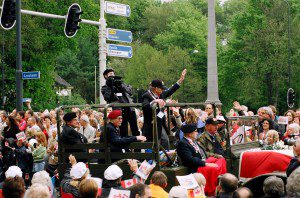
Canadians were featured prominently that day. Grateful Netherlanders lined the streets, at first, in an orderly fashion. They waved, cheered and tossed tulips – the first blossoms of that bittersweet springtime when six long years of war came to an end. They celebrated the end of Nazi occupation in their country and embraced their liberators. It was May 8, 1945, Victory in Europe (VE) Day. Among those liberators marching in the Apeldoorn parade on the receiving end of all that adoration was a young lieutenant from Arnprior, Ontario. Barclay Craig remembered being told it would be a half-hour parade.
“It was actually the eve of my 25th birthday,” he told me this week. “The Dutch were so excited to be free again, they crushed in around us in the parade. I never shook so many hands in my life.”
Craig is one of 40 travellers with me in Holland this week. We’ve been crisscrossing the country planting maple leaf flags at gravesites in Canadian war cemeteries, exploring museums large and small, and paying tribute to Canadian veterans from within our group and elsewhere.
Last Wednesday evening at sunset, the small Dutch community of ’s Heerenberg (on the Holland/Germany border) escorted our veterans to the central town square. There the mayor and dignitaries unveiled an artillery piece, known as a 25-pounder (the weight of the shell it fired). Almost exactly 65 years previously, members of the 12th Field battery of the Royal Regiment of Canadian Artillery – using 25-pounders – had crossed the nearby Rhine River to launch a final battle against retreating Germany armies.
Sylvia McTavish, also with my tour group, recalled the moment well. Her husband Ray McTavish had served with the 12th Field. In fact, Sylvia had brought along the regimental war diary that described the nighttime scene in late April 1945. “There seemed to be a solid row of guns firing from our side of the Rhine … The whole sky burst into flames as the hundreds of guns fired continuously and hurled … tons of shells into the [Germans’] last defence line. By midnight first reports showed the attack progressing favourably.”
The ceremony at ’s Heerenberg illustrated to all present the impact of Canadian volunteers a generation ago. It also commemorated the cost – between D-Day (1944) and VE Day (1945), 29,000 Canadian gunners had employed 1,100 artillery pieces to help liberate Europe from Normandy to the Rhine. But the 38 Canadian artillery regiments had also sustained 900 casualties. Gunner Ray McTavish lived to witness his enemy surrender on May 8, 1945, but he would also contract a virulent strain of tuberculosis that would kill him not long after his repatriation to Canada.
“I still felt very proud,” Sylvia McTavish said, “that the Dutch would pay such a moving tribute.”
Last Sunday proved a fitting climax to our pilgrimage across the Netherlands. In Holland’s original palace city, Apeldoorn (liberated during those same last days of the war), Dutch citizens lined both sides of the main streets for a kilometre and a half to show their appreciation as hundreds of their former liberators – the Canadians – marched or motored past. The spectators applauded, cheered and even ran alongside the vintage jeeps and trucks (as their parents had a generation ago) to embrace the vets one last time.
Accompanying one of those Canadian vets in the Apeldoorn parade was a young air force cadet from London, Ontario. Sixteen-year-old Boughdan Gibbons had never travelled to Europe, much less witnessed an historic nationwide commemoration in Holland before.
But his stepmother, Audrey deVoest (Merit Travel tour guide on our trip), had negotiated Bo’s release from school for 11 days to join our tour. She had also encouraged him to pack his cadet uniform just in case. It and he were part of Sunday’s VE Day parade as Bo rode with Ron Charland, another of our Dutch liberation vets from Quebec.
“I’d never really thought much about the war,” Bo Gibbons said later. “But being here with the vets somehow gave it more meaning. I’ll never forget this trip.”
A couple of vehicles away from air cadet Gibbons and Quebec veteran Charland, former signalman Barclay Craig stood in the box of a small troop transport truck. As he had done during the original VE Day parade in May 1945, through Sunday midday Craig accepted effusive praise from the citizens of Apeldoorn. He received their flowers, their applause, their adoration one last time. He reminded me that he had turned 25 that day 65 years ago. That meant last Sunday, when he repeated the victory walk, he turned 90.
“Being here has made me remember a lot,” Barclay Craig said, “the starvation of the people, the dedication of ordinary Canadian soldiers. It’s extraordinary.”
I was not in a parade in Appledoorn in 1945. I was there but no parade. It was in 1985 that I was back there, I believe the date was May 8, and then there was a parade for the 40th Anniversary, that went on for about two hours. Well, it really could not be called a parade. It was a very long handshaking walk. Lots of thank-you’s and tears. This year’s was the same without the walking.